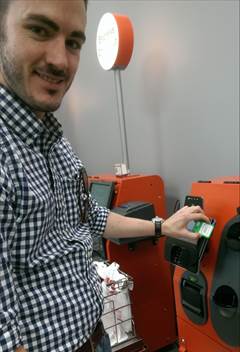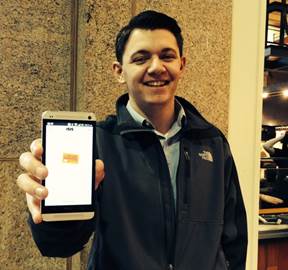Tapping and Zapping Our Way through Boston 
Recently, members of the Boston Fed's Payment Strategies team [1] grabbed their smartphones and used their devices to shop, eat and pay around Boston. We paid using several new mobile payment services, including Softcard, Google Wallet, LoopPay, and LevelUp for our purchases at pharmacies, big box retailers, and meals at food trucks and restaurants.
Softcard and Google Wallet use near-field communication (NFC) technology and allow consumers to tap and pay in a store where contactless payments are accepted (the contactless logo is usually displayed on the card reader or payment terminal). LevelUp is a mobile app that allows customers to scan a QR code (2D barcode) at the checkout terminal to pay. LoopPay uses a mobile app paired with either a customized fob or phone case (we used the fob). To pay, a customer places the LoopPay fob very close to the credit card swipe slot on a terminal and presses a button to emulate the same magnetic signal as
a magnetic striped credit card swipe (using magnetic secure transmission (MST) technology).[2]
Team members have a variety of smartphones-including iPhone 5S and NFC-enabled Android phones. In some instances, the phone model and mobile carrier affected which mobile payment service that could be used. For example, Google Wallet's tap-and-pay functionality only works with NFC-enabled Android devices running 4.4 KitKat or higher. An AT&T, T-Mobile or Verizon customer with an NFC-enabled Android phone can use Softcard by first obtaining a special SIM card from the mobile carrier. Softcard also offers an iPhone case containing an NFC antenna for iPhone users. LevelUp and LoopPay can be used on most Android phones and iPhones with any major mobile carrier.
Whether iPhone or Android, the Payment Strategies team was able to easily download the free mobile payment apps for each service from the respective app stores. All of the apps downloaded quickly and used very little memory space. After registration, we added a credit or debit card to either our Google Wallet or LevelUp account by manually entering the 16-digit card number and CVV security code. LevelUp users can also load their cards by taking a photo of the credit or debit card with the phone camera. A customer can link any major credit or debit card to Google Wallet and LevelUp. Softcard accepts American Express (AmEx), Chase and Wells Fargo credit and debit cards or users can open an AmEx Serve prepaid account and connect any major bank-issued card through Serve. Some of us already had eligible credit cards, and others opened a new AmEx Serve prepaid account. To add cards to LoopPay, we could either swipe them through the plug-in card reader (which also serves as the fob for payment) or take a photo with the phone camera. Some of us tried swiping cards with the LoopPay reader multiple times before they were eventually loaded successfully.

Once everyone completed the enrollment processes, the team embarked on a retail adventure to test our new mobile payment accounts. We used Google Wallet and Softcard at CVS, Rite Aid and Walgreens as they are the primary retailers with contactless POS readers around Boston. We tapped and paid for our purchases without any difficulty. We did not get a significant reaction from sales associates or other customers, although a few cashiers seemed intrigued by the new technology.
We also tried paying with the LoopPay fob at a variety of retail venues, including big box retailers such as Walmart, Target and BJ's, small 'mom and pop' shops, restaurants (e.g., Applebee's) and gas stations. LoopPay worked in most places, but we concluded that it was best suited for checkout at stores with customer-facing point-of-sale (POS) terminals that allow a customer to swipe his own credit card. While we could hand our LoopPay fob to the cashier, it proved to be inconvenient and less efficient, requiring an additional step and explanation as fewer retailers are familiar with the LoopPay technology.
We used LevelUp to pay for lunch at the food trucks in Boston's Dewey Square. Employees of merchants accepting LevelUp were usually well-informed of how the mobile
payment app works. LevelUp transactions were completed smoothly, with only one exception when a solar glare made it difficult for the food truck's scanner to read the QR code on the phone screen. From our observations, staff and customers appear familiar with LevelUp. Kevin used the LevelUp app on his Pebble smartwatch to pay for lunch. The cashier initially seemed confused but thought it was fascinating once Kevin explained what he was doing.

Security is often a primary concern around mobile payments. Overall, we were comfortable with the security features that Softcard, Google Wallet, LoopPay and LevelUp provided. All four mobile payment apps provide a PIN-lock feature that can be set-up during enrollment. If our phones are lost or stolen, we can disable the apps remotely. Softcard, Google Wallet, and LevelUp display only the last four digits of the customer's linked credit or debit card number on the screen in their apps. LoopPay's app displayed the entire credit/debit card account number instead of masking part of it, which could cause some security concerns. After completing a transaction using Softcard, Google Wallet, and LevelUp, we each received a push notification and email receipt confirming the purchase, and we could view transaction history in each respective app.
The team also tried other features available with Softcard, Google Wallet and LevelUp, such as loyalty rewards and location-based promotions. Jake was incented to try some new dining spots with first-visit promotions and enjoyed loyalty discounts at his favorite food trucks using LevelUp. He noted, "I personally find mobile payments a great way to purchase goods because it's fast, easy and eliminates the need for me to carry cash, which I will find the greatest challenge to adjust to when I go home [to Ireland]." Aaron enjoyed many free smoothies during the [Softcard] Jamba Juice 'Million Smoothie or Juice Giveaway.' He also takes advantage of Google Wallet's location- based offers regularly. Aaron explained, "I like the simplicity of using mobile wallets because they integrate my transaction history, loyalty programs, and track my orders within one app. The wallets also use geo-location to let me know when I am at one of my loyalty program locations with a pop-up notification."

We had an exciting and insightful mobile payments expedition. In most cases, mobile payments provided an easy, convenient checkout experience that often resulted in rewards and additional savings. However, we observed a few improvement opportunities. The NFC feature needs to be turned off when not in use in some Android phones because it drains the battery if left on continuously. This can be inconvenient for making mobile NFC payments. The limited types of eligible cards, number of stores (currently estimated at 220,000) accepting contactless payments, and availability of NFC-enabled phones can make it challenging to use mobile payment services like Softcard and Google Wallet. This was the case when we conducted our mobile payment experiments in July 2014 (before the Apple Pay announcement). As more banks and merchants participate in mobile payment initiatives and more phones are equipped with NFC, including the new iPhone 6, there will undoubtedly be more opportunities for everyone to enjoy the robust features and value mobile payments offer as we did. Stay tuned for more mobile payments adventures-maybe next time you can also tell us about yours![3]
Disclaimer: The views expressed in this article are those of the participants and do not necessarily represent the views of the Federal Reserve Bank of Boston or the Federal Reserve System. Mention or display of a trademark, proprietary product, or firm in this article does not constitute an endorsement or criticism by the Federal Reserve Bank of Boston or Federal Reserve System and does not imply approval to the exclusion of other suitable products or firms.
[2] We had to register for each mobile payment service and link our credit/debit card information prior to use. For more information, see https://www.google.com/wallet/; https://www.paywithisis.com/; https://www.thelevelup.com/; http://www.looppay.com/
[3] For more information about mobile payments in the Boston area, see "A Day in the Life of Mobile Payments" http://www.bostonfed.org/bankinfo/payment-strategies/everyd ay-mobile/a-day-in-the-life.htm.

 About the Authors
About the Authors
Elisa Tavilla,
Federal Reserve Bank of Boston
Email: Elisa.Tavilla@bos.frb.org



